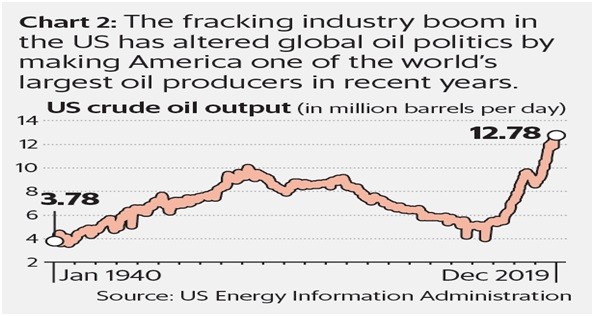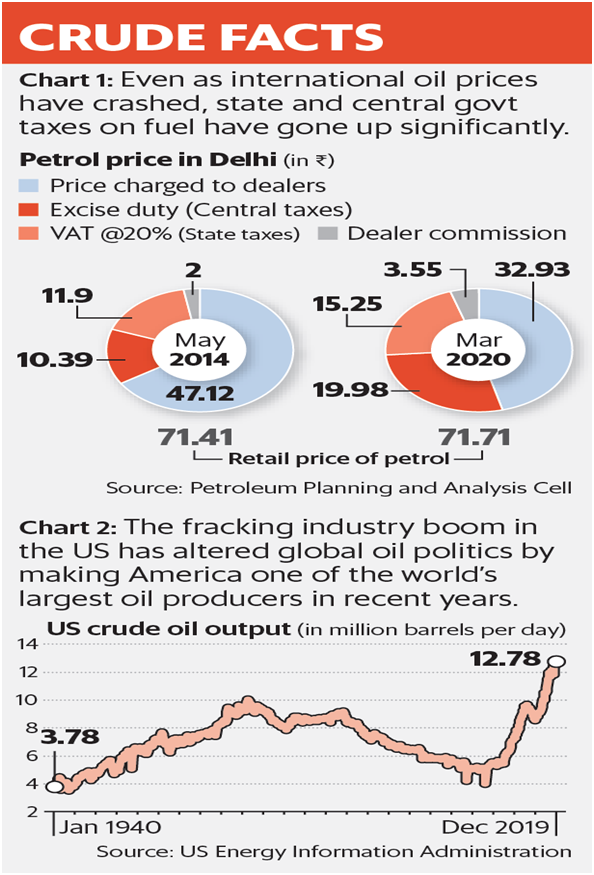As Saudi Arabia initiated a price war against Russia, the crude oil price fell by 30 percent, registering its single-largest fall since the 1990 Gulf War.
Brent Crude - a key international benchmark price index for oil — continued to trade around the $30 mark Monday(09/03/2020).
Why 60 years' old OPEC broke down?
Why Saudi Arabia cannot continue with OPEC?
Saudi Arabia wanted to reduce prices by increasing production to beat the US shale industry however Russia and other OPEC members didn't agree with it as they feared falling crude prices due to a fall in demand for oil due to the spread of coronavirus and resultant lockdowns to control it.
In chart 2 below if you can see how US production of oil has increased recently over the past years. This is due to shale industry expansion over the past few years.
Simply put, the Saudis, the world's top oil exporter, are trying to destroy the shale oil industry in the US, which isn't viable at sub-$50 per barrel and create some trouble for the Russian oil industry as well.

While Saudi Arabia produces oil at very low rates, its government's massive expenditure is highly dependent on high oil prices. As per the International Monetary Fund (IMF), the break-even price for the Saudi Arabian government to be able to meet its expenditure in 2020 is expected to be at $83.6 per barrel.

How will falling oil prices impact India?
Given that the country is the world's third-largest crude consumer and imports close to 85% of the oil that it consumes, any fall in oil prices is a relief, as the import bill comes down.
But will the Indian consumer get to see lower petrol and diesel prices?
The safe answer here is, given that state governments are facing a slowdown in tax collections, they are likely to capture some of the falls in prices by increasing the value-added tax (VAT)/sales tax they charge on petrol and diesel. Also, in the recent past, the central government has tended to increase the excise duty on petrol and diesel when oil prices have fallen.

India's import dependency on crude oil in FY20 (April 2019 to January 2020) has shot up to 84.9%, as against 83.6% during the same period in FY19.
Between April 2019 and January 2020, India had imported around 188.4 million tonnes of crude oil and paid $87.7 billion for it. The price of the Indian basket of crude oil has averaged at $64 per barrel during the period. As of 6 March, the price of the Indian basket of crude oil was quoting at $47.92 per barrel. By 10 March, it had fallen to $34.52 per barrel, a fall of 28% in a matter of days. As a result, there are bound to be savings on this front, at least in the short term.
Another point that needs to be remembered here is that crude oil is bought and sold internationally in dollars. When an Indian company imports oil, it needs to pay for it in dollars. This pushes the demand for dollar vis-à-vis the rupee. With oil prices falling, the dollar demand for oil imports is going to come down and this should act in India's favour at a time when there is tremendous downward pressure on the rupee.
In May 2014, the month in which Narendra Modi took oath as the Prime Minister for the first time, the price of the Indian basket of crude oil averaged at $106.85 per barrel. The price of petrol in Delhi then was ₹71.41 per litre.
On 1 March 2020, the price of petrol in Delhi was ₹71.71 per litre. This is when the Indian basket of crude oil was at around $50 per barrel. Despite crude oil prices having fallen by over 50% over the last six years, the price of petrol in Delhi has continued to remain the same.
One reason for this lies in the fact that the rupee has lost ground against the dollar in the last six years. One dollar was worth around ₹58-59 in May 2014. Now it's worth around ₹73-74. Over and above this, central and state taxes on petrol and diesel have also gone up, between then and now.
This time it is nothing different the government on Monday amended the law to get enabling powers to raise excise duty on petrol and diesel by Rs 8 per litre each in future.
Finance Minister Nirmala Sitharaman moved an amendment to the Finance Bill, 2020, to raise the limit up to which the government can raise special excise duty on petrol and diesel to Rs 18 per litre and Rs 12, respectively.
The government had on March 14 raised excise duty on petrol and diesel by Rs 3 per litre each to raise an additional Rs 39,000 crore in revenue annually. This duty hike included Rs 2 a litre increase in special additional excise duty and Re 1 in road and infrastructure cess.
IMPACT OF CRUDE PRICES ON STOCK MARKET
It is popular to correlate changes in major factor prices, such as oil, and the performance of major stock market indexes. Conventional wisdom holds that an increase in oil prices will raise input costs for most businesses and force consumers to spend more money on gasoline, thereby reducing the corporate earnings of other businesses. The opposite should be true when oil prices fall.
However, it goes two ways because of the diversity of industries. High oil prices can drive job creation and investment as it becomes economically viable for oil companies to exploit higher-cost shale oil deposits. However, high oil prices also hit businesses and consumers with higher transportation and manufacturing costs. Lower oil prices hurt the unconventional oil activity, but benefits manufacturing and other sectors where fuel costs are a primary concern.
So to be general a little or no correlation exists between oil prices and stock prices.
However, oil prices impact on oil exploring and marketing companies can be very well judged.
First of all we need to understand the basic concept of oil companies.Industry can be divided into two main groups: upstream and downstream companies. Upstream companies are directly involved in the exploration and production of crude oil. Their job is to locate and test potential drilling sites and then set up the facilities for oil extraction. Downstream companies refine and distribute the finished products, including gasoline and diesel fuel.
Upstream companies are hit hardest when oil prices fall since the price at which they sell oil is determined by the market, but their costs of production are largely fixed. If it costs more to produce a barrel of oil than it would fetch on the market, producers will incur losses and eventually go under. Large, expensive and capital-intensive drilling operations are hit harder than smaller, more nimble rigs, which can shut down temporarily and then restart once prices rise. Downstream companies will not be hit as hard since they profit by purchasing crude oil and selling the refined products at a premium. Their profit margins should remain fairly stable even with fluctuating oil prices.
The impact of every 50 paise increase in the marketing margin could potentially lift expected earnings of the OMCs for the next fiscal year in the range of 15-30 per cent. The biggest beneficiary will be HPCL, followed by BPCL and IOC. HPCL's proportion of marketing sales to refinery throughput is the highest. In the first nine months of FY20, HPCL had domestic marketing sales of 29 million tonnes, while its refinery throughput was 12.6 mt. BPCL had marketing sales of 32.4 mt and refining throughput of 23.5 mt. The benefit accrued from higher marketing margin minimises the earnings hit coming from the refinery segment due to inventory losses.
So why shares of oil companies' shares still going down?
Take an example of BPCL whose share price was 412.35 on March 2, 2020 and it fell down to 267.40 on March 24,2020.
So let us understand it. Revenue consists of two parts first is Price and second one is Quantity.
Due to the spread of coronavirus, the demand of petrol and diesel has gone down which further reduced the quantity supplied by these companies.Price remaining constant and quantity supplied going down reduced the revenue of these companies. So they are not able to reap the benefits of reduced crude prices.







 CAclubindia
CAclubindia
